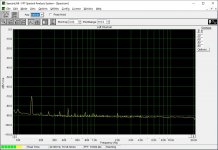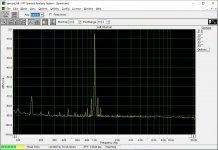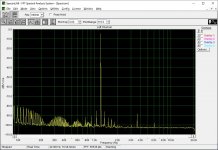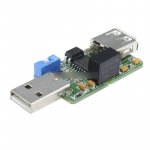I tried TrueRTA free version that has a sig gen, the issue is output level specified in dBu, not dBfs. I tried VA too.
REW's signal generator has output in dBfs
REW - Room EQ Wizard Room Acoustics Software
This device is just what we need as it has spdif and I2S outputs, configurable format and bit depths. Pity it is no longer available.
JKGEN - ALTOR AUDIO
JKGEN - ALTOR AUDIO
This device is just what we need as it has spdif and I2S outputs, configurable format and bit depths. Pity it is no longer available.
JKGEN - ALTOR AUDIO
I have asked the manufacturer about the replacement as it does seem to be a very useful device for anyone building their own dac, so, depending on the cost, maybe a group buy could be arranged?
Spurious peaks were caused by some earth loop (same computer was used for signal out and signal in on two different USB interfaces). Attached is the baseline and 1kHz 0dB with separate PCs (analyzer not calibrated). Overtones disappeared, but I can't go below -90dB noise floor.
Attachments
Spurious peaks were caused by some earth loop (same computer was used for signal out and signal in on two different USB interfaces). Attached is the baseline and 1kHz 0dB with separate PCs (analyzer not calibrated). Overtones disappeared, but I can't go below -90dB noise floor.
-90db is low enough surely? Are you in an anechoic chamber!
The background noise in my listening room is about 30 and normal listening volume is about 90, and maybe 100db on peaks so I wouldn't notice if my snr was better than about 75db. (unless I was using headphones)
So you've never actually listened to any of the latest TDA1541a dac incarnations with for example, simultaneous mode, and/or balanced, and/or transformer output?
Latest
 . That's a good one. There is a thread on simultaneous operation of the TDA1541A from 2004. Been through the NOS shenanigans with TDA1541A in a CD104, built the balanced TDA1541A circuit from HFN/RR and don't care much for transformers. Had them in an Audionote. Much better without them.
. That's a good one. There is a thread on simultaneous operation of the TDA1541A from 2004. Been through the NOS shenanigans with TDA1541A in a CD104, built the balanced TDA1541A circuit from HFN/RR and don't care much for transformers. Had them in an Audionote. Much better without them.Latest. That's a good one. There is a thread on simultaneous operation of the TDA1541A from 2004. Been through the NOS shenanigans with TDA1541A in a CD104, built the balanced TDA1541A circuit from HFN/RR and don't care much for transformers. Had them in an Audionote. Much better without them.
Fair enough. I was wondering and yes, I've read this thread from the start.
Ideas come and go. E.g the various dem clock frequencies, I/V methods, I2S attenuation, parallel or balanced etc. Yet there is no definitive way to use the TDA1541.
I still have a pair of AD1865s and 4, AD1862s to compare with when I get round it so I am keeping an open mind.
Ps there's no fun in just buying a commercial product.
Spurious peaks were caused by some earth loop (same computer was used for signal out and signal in on two different USB interfaces). .
A good USB interface, like that ADUM4160 isolator, not only serves for listening but also for other critical data handling in USB devices. Not perfect but better than nothing.
I imagine better chips will appear, if not already here.
Cheer,
M.
Latest. That's a good one. There is a thread on simultaneous operation of the TDA1541A from 2004. Been through the NOS shenanigans with TDA1541A in a CD104, built the balanced TDA1541A circuit from HFN/RR and don't care much for transformers. Had them in an Audionote. Much better without them.
Hey rfbrw!
Heve you done trials with NOS-TDA1541 but upsampling/DF in Foobar? I've got my TDAs running over the Foobar->ResamplerV@176kHz(SOX, various filter param.). Must be a quantum leap over the SAA7220P/x - What do you think?
Hey rfbrw!
Heve you done trials with NOS-TDA1541 but upsampling/DF in Foobar? I've got my TDAs running over the Foobar->ResamplerV@176kHz(SOX, various filter param.). Must be a quantum leap over the SAA7220P/x - What do you think?
I see no point in generating audio data with a greater word length only to then truncate it because I'm hamstrung by a 16-bit dinosaur.
I see no point in generating audio data with a greater word length only to then truncate it because I'm hamstrung by a 16-bit dinosaur.
Yet of course dynamic range of 16bit word length is not in question here, the sampling rate was the question.
Also WRT harmonic distortion, lower order even and odd spectra from a guy who has forgotten more than most of think that we know.
Just looking at the FFT I know what I would prefer to be listening to/with.
BTW Thorsten's tube Stage for TDA1541A Post #22
Last edited:
Yet of course dynamic range of 16bit word length is not in question here, the sampling rate was the question.
Also WRT harmonic distortion, lower order even and odd spectra from a guy who has forgotten more than most of think that we know.
Just looking at the FFT I know what I would prefer to be listening to/with.
BTW Thorsten's tube Stage for TDA1541A Post #22
Good for you, dude but I ain't drinking the kool-aid no matter which guru is offering the cup.
Thanks for the hint, I ordered one. I will report on the results.A good USB interface, like that ADUM4160 isolator, not only serves for listening but also for other critical data handling in USB devices. Not perfect but better than nothing.
I imagine better chips will appear, if not already here.
Cheer,
M.
Attachments
Thanks for the hint, I ordered one. I will report on the results.
You're welcome.
As I like to complicate my-self, I ordered years ago several PCBs from this gentleman:
https://www.circuitsathome.com/adum4160-usb-isolator-assembly-guide/
This allows to configure it as you please and try different flavors of VRegs.
As I said, not perfect but much better than direct USB connection soundwise, save if you have a Mosaic DAC, hehe.
I have not used it for other tasks, though. I forgot to mention that there might be speed issues, depending on the task. Look for high speed transmission compliant devices.
Best wishes,
M.
Last edited:
Good for you, dude but I ain't drinking the kool-aid no matter which guru is offering the cup.
Do you currently use, or do you plan to use a 1541A based DAC?.
Last edited:
Thanks for the hint, I ordered one. I will report on the results.
I have an ADUM160N 6channel isolator and some soic to dip adaptor pcbs so I can try it between the ebay usb-i2s interface and the I2S input on IanCanada's FifoII.
I have also decided I prefer the sound with the transformer primary centre tap disconnected instead of to either ground or having current fed in to cancel the dac's output offset.
I also tried a transformer coupled solution, but I did not like it compared to a simple resistor I/U converter stage. The analog amplifier stage was the same in both cases, even the resistor type was the same in the I/U and in the secondary of the trafo. The values were different of course. I felt loss in the bass region although the mids and hights were smoother a bit.
Do you currently use, or do you plan to use a 1541A based DAC?.
Does it matter?
Does it matter?
Well, RFBRW, to me it seems that you either have to share something great here, but for some reason you don't want to release right now, OR you're reading this thread for some interest...
What is it
- Home
- Source & Line
- Digital Line Level
- Building the ultimate NOS DAC using TDA1541A



